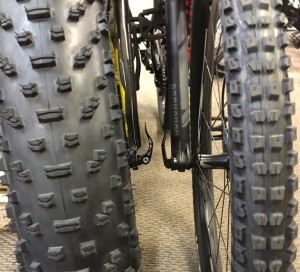Winter Bicycling Keeps us Riding Yearlong.
Does the current talk about El Nino bringing epic snowfall to the Sierras this winter and its excitement about riding it mean the end of bicycling season? No, bicycling during the winter can be fun and complement our winter sport activities.
For many of us, bicycling is not a seasonal activity but rather an ongoing lifestyle choice for commuting, and health and fitness – yearlong. Depending on the time of year, weather conditions can affect our riding choices. Let’s take a look at bicycling during winter conditions.
Winter Bicycling Preparations.
Typically, winter can bring colder temperatures, rain, snow and ice, but these conditions do not have to prevent us from enjoying the benefits of riding our bike. However, these conditions can prompt us to take into account some adjustments to our bike, clothing, and activities in order to be safer, more comfortable, and have the best possible ride.
Those of us living in cold, wet or snowy environments are accustomed to these conditions and are likely to have a cache of accessories to help keep us dry, warm and comfortable. You can use these while bicycling too.
Here are a few suggestions for bicycling in winter conditions:
- Bike Type. Bikes with wider knobby tires provide the most traction on slippery surfaces.
- Tire Pressure.
 Slightly deflate tire pressure to increase traction on wet, icy or snow conditions
Slightly deflate tire pressure to increase traction on wet, icy or snow conditions - Fat Tires. Try the new fat (balloon) mountain bike tires to increase traction on slipperysurfaces. These tires are 4.6 inches wide compared to a typical 2.35 mountain bike tire size.
- Studded Tires. For extended periods of snow covered ground you can get studded tires.
- Clean drive train. Be sure to keep your gears and chain clean after each use.
- Lights. Have proper head lamp and rear lights when riding during dark hours.
- Layered Clothing. Use a layer technique with a base layer, another garment and outer shell to prevent getting wet. Keep in mind you will shortly generate body heat. Avoid perspiring as this will definitely chill you. Wearing leg warmers is also very helpful.
- Foot Wear. Wear wool socks not cotton. If very cold, wear cycling booties over your shoes, or I’ve used plastic bags to cover my feet. Winter boots can work well without clip less peddles.
- Hand Wear. Warm water repellent gloves with grip are helpful.
- Head Wear. Wear a beanie or liner under your helmet when real cold.
- Indoor Training. Get a cycle-trainer for your bike and/or take spinning classes.
- Travel. Travel to another area where the conditions are not winter-like. I’ll leave the snow level and travel to lower elevation valleys to ride during the winter.
By adopting some of these suggestions you can enjoy winter bicycling, receive benefits from yearlong riding, and be fit and ready for the spring and summer bicycling events.
See you on the ride,
Ty, The Bike Guy


